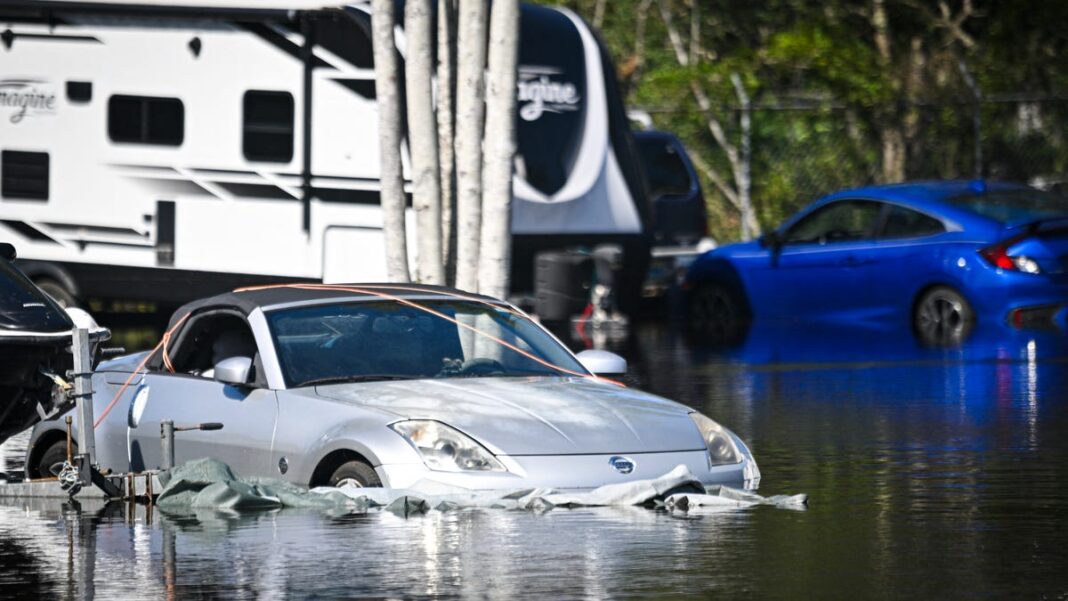Officials alert that electric vehicles may ignite amid Helene’s flooding: Key insights
The impact of Hurricane Helene extends far beyond its 100-plus fatalities and power interruptions affecting roughly 1.6 million homes, as it has inundated roadways and vehicles throughout the Southeast.
Following the storm’s landfall in Florida’s Big Bend late Thursday, relentless rain has wreaked havoc on vehicles and homes across Florida, the Carolinas, Georgia, Tennessee, and Virginia. Numerous water rescues have been conducted in affected regions.
The Associated Press reports at least 133 fatalities attributed to this disastrous storm. The ensuing floods and landslides have resulted in homes being swept away, bridges collapsing, grocery items pouring into the streets, and semi-trucks being upturned into chaotic heaps.
Prior to Helene’s impact, Florida Governor Ron DeSantis cautioned owners of electric vehicles (EVs) to relocate their cars to higher ground to mitigate fire risks.
“If you own an EV, you should move it to higher ground,” DeSantis stated during a Wednesday press briefing. “Be wary of potential flooding as it may lead to fires.”
After Hurricane Ian caused 156 fatalities in 2022 and damaged an estimated 358,000 vehicles in Florida and the Carolinas, only 21 electric vehicles have reportedly caught fire, which is significantly less than originally anticipated.
Here’s what to consider regarding the effects of flooding on electric vehicles.
Do submerged electric vehicles pose a fire hazard?
Experts indicate that electric vehicles are not disproportionately at risk of igniting from flooding, with only a small fraction of registered EVs experiencing such incidents, as per YSL News evaluations.
Out of every 100,000 electric vehicles, approximately 25 are reported to catch fire annually, as per statistics collected by AutoInsuranceEZ.
In contrast, approximately 1,530 fires occur each year for every 100,000 gasoline vehicles, largely attributed to fuel leaks or accidents.
What causes fires in flooded electric vehicles?
In the event that flooding leads to an electric vehicle catching fire, this is generally due to collisions or water penetration, which cause battery short circuits.
This infrequent occurrence is labeled as thermal runaway, wherein energy discharges among battery cells, generating heat and potentially resulting in a fire.
What to do if your vehicle is submerged?
If your car stops functioning in rising waters, do not attempt to restart it, as this can inflict further damage on the engine and its components.
Instead, AAA advises you to exit the vehicle promptly and seek higher ground or a safe area.
Tesla gives the following recommendations if your vehicle has submerged:
- Get in touch with your insurance company.
- Avoid operating the vehicle until it has been examined by a certified service center.
- Move the vehicle at least 50 feet away from buildings, vehicles, personal property, and other flammable materials.
What steps to take after recovering a vehicle from flooding?
Before using your vehicle after it has been removed from the water, AAA specialists suggest checking for damage. The extent of the damage will be determined by how high the water reached. If the water level remained below the doors, your car likely sustained minimal damage.
However, if the water exceeded the bottom of your doors, experts recommend against attempting to restart the vehicle. Doing so could lead to water entering the engine, causing irreversible harm.

